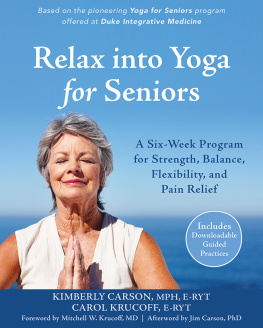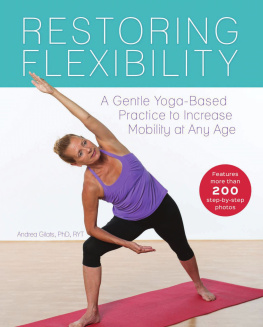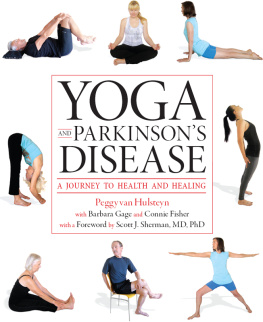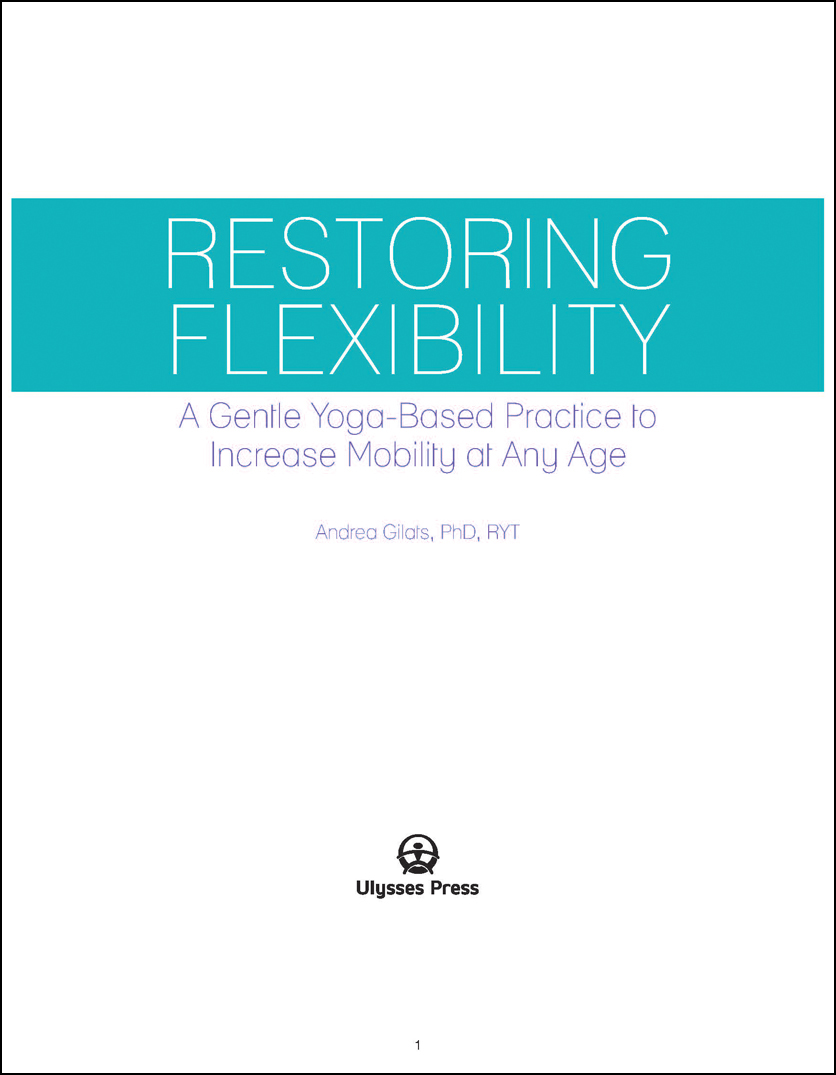
Text copyright 2015 Andrea Gilats. Photographs copyright 2015 Rapt Productions except as noted below. Design and concept copyright 2015 Ulysses Press and its licensors. All rights reserved. Any unauthorized duplication in whole or in part or dissemination of this edition by any means (including but not limited to photocopying, electronic devices, digital versions, and the Internet) will be prosecuted to the fullest extent of the law. Published in the United States by: Ulysses Press P.O.
Box 3440 Berkeley, CA 94703 www.ulyssespress.com ISBN: 978-1-61243-499-5 Acquisitions: Casie Vogel Managing editor: Claire Chun Editor: Lily Chou Proofreader: Lauren Harrison Indexer: Sayre Van Young Front cover/interior design and layout: what!design @ whatweb.com Cover artwork: Rapt Productions Interior artwork: Rapt Productions except page 7 Jacob Lund/shutterstock.com; page 18 Pressmaster/shutterstock.com; page 39 sciencepics/shutterstock.com (hamstring) and Sebastian Kaulitzki/shutterstock.com (psoas); page 83 otnaydur/shutterstock.com; page 93 Kudla/shutterstock.com Models: Baxter Bell, Andrea Gilats, Toni Silver Distributed by Publishers Group West Please Note: This book has been written and published strictly for informational purposes, and in no way should be used as a substitute for consultation with health care professionals. You should not consider educational material herein to be the practice of medicine or to replace consultation with a physician or other medical practitioner. The author and publisher are providing you with information in this work so that you can have the knowledge and can choose, at your own risk, to act on that knowledge. The author and publisher also urge all readers to be aware of their health status and to consult health care professionals before beginning any health program. This book is independently authored and published. No sponsorship or endorsement of this book by, and no affiliation with, any trademarked brands or products mentioned or pictured is claimed or suggested.
All trademarks that appear in this book belong to their respective owners and are used here for informational purposes only. The author and publisher encourage readers to patronize the quality brands and other products mentioned and pictured in this book. CONTENTS
Guide
In 2006, life handed me a double whammy. I was diagnosed with both emphysema and Crohns disease. I had probably been living with these conditions for years, but because I had grieved so long and hard after the loss of my husband to cancer in 1998, I hadnt paid attention to the slow but relentless worsening of my symptoms. But the universe works in mysterious ways and, as luck would have it, in late 2007, I moved into a condominium building that had a fitness center next door to it.
My 62-year-old body joined the gym, and I began working with a trainer twice a week. Shortly after I started strength training, my gym began offering a yoga class. I decided to give it a try. From the moment I found yoga, I felt like a duck in water. What amazed me was that the negative stories I had been telling myself about my physical abilities seemed irrelevant when it came to yoga. Ive never been particularly athletic; Ive never been good at sports.
Back then, I spent most of my day at my desk or in meetings and, in the evening, I turned into a couch potato. But yoga changed all that. After years of avoidance, I had finally found a way to restore my confidence in my physical abilities. No matter when you come to yoga, youll carry your bodys history with you to the mat. There, to my surprise, I learned that my history didnt limit me at all, nor did my age or my diseases and conditions. I began to realize that yoga was something I could get better at through practice, so I stayed with it.
After just a few weeks, I began to see and feel the positive changes in my body. I also found myself feeling more energeticI actually began to enjoy moving! By restoring my flexibility, I regained the mobility I had lost through inactivity, and because I had become more agile, physical activity became a pleasure, not a chore. Even housework became easier! As a yoga teacher with a checkered body history, I want to help ensure that the continuing story of your body is long and happy. The purpose of this book is to help you restore your flexibility so that you can increase your mobility, stay active and independent as you age, and live longer. To help you meet these goals, I offer a safe, age-appropriate, individually customizable approach to yoga-based exercise for those of you whove never tried yoga and those of you whove practiced yoga in the past and would like to reconnect with it. release tightness in your shoulder joints so you can move your arms freely and reach farther. relax the muscles in your torso so you can twist and turn easily while keeping your spine safe. mobilize your hip joints and the muscles that move them so you can comfortably lengthen and widen your stance and bend forward, backward, and sideways without aggravating your low back. lower yourself to the ground and get up again safely and confidently so you can improve your agility, enjoy greater total-body flexibility, and reduce your chances of falling. lower yourself to the ground and get up again safely and confidently so you can improve your agility, enjoy greater total-body flexibility, and reduce your chances of falling.
As you move through your yoga flexibility program, youll see that your range of motionhow far you can comfortably move each part of your body in any directionis expanding. Thats flexibility. Youll also discover that youre becoming better able to safely and easily change your body position. Thats agility, flexibilitys kissin cousin. As your flexibility practice becomes a regular habit, I hope youll find yourself wanting to move more.  In his landmark 2008 book, The Longevity Revolution, renowned physician and gerontologist Robert Butler says that from the Bronze Age to the end of the 19th century, life expectancy grew by only an estimated 29 yearsfrom about 20 to about 50 years.
In his landmark 2008 book, The Longevity Revolution, renowned physician and gerontologist Robert Butler says that from the Bronze Age to the end of the 19th century, life expectancy grew by only an estimated 29 yearsfrom about 20 to about 50 years.  In his landmark 2008 book, The Longevity Revolution, renowned physician and gerontologist Robert Butler says that from the Bronze Age to the end of the 19th century, life expectancy grew by only an estimated 29 yearsfrom about 20 to about 50 years.
In his landmark 2008 book, The Longevity Revolution, renowned physician and gerontologist Robert Butler says that from the Bronze Age to the end of the 19th century, life expectancy grew by only an estimated 29 yearsfrom about 20 to about 50 years.
But since the beginning of the 20th century in the industrialized world, there has been an unprecedented gain of more than 30 years of average life expectancy. I call this unprecedented demographic transformation the Longevity Revolution. All of us reading this book are part of this transformation. We areor will bethe lucky recipients of an ever-lengthening era of physical, intellectual, and social vitality after midlife. These extra years arent tacked on to the ends of our livesthey come at a time when were healthy enough to enjoy them. Thanks to modern medical advances like antibiotics and vaccines, this bonus era can last for two or three decades or more.
Better yet, the longer youve lived, the longer youre going to live. For example, if youre one of the 60 million Americans who have made it to age 60, odds are youre going to live another 20 to 30 years. Our bonus years can be the best of our lives, but if we dont move our bodies regularly and frequently, well gradually lose our mobility and, with it, our ability to live independently. The bottom line? The longer we can preserve our mobility, the longer well live. Its never too early or too late to take care of our future selves, especially when doing so can bring us joy in the present moment. When we fail to do the things today that will help ensure a longer, brighter succession of tomorrows, we arent being fair to ourselves.









 Text copyright 2015 Andrea Gilats. Photographs copyright 2015 Rapt Productions except as noted below. Design and concept copyright 2015 Ulysses Press and its licensors. All rights reserved. Any unauthorized duplication in whole or in part or dissemination of this edition by any means (including but not limited to photocopying, electronic devices, digital versions, and the Internet) will be prosecuted to the fullest extent of the law. Published in the United States by: Ulysses Press P.O.
Text copyright 2015 Andrea Gilats. Photographs copyright 2015 Rapt Productions except as noted below. Design and concept copyright 2015 Ulysses Press and its licensors. All rights reserved. Any unauthorized duplication in whole or in part or dissemination of this edition by any means (including but not limited to photocopying, electronic devices, digital versions, and the Internet) will be prosecuted to the fullest extent of the law. Published in the United States by: Ulysses Press P.O.  In his landmark 2008 book, The Longevity Revolution, renowned physician and gerontologist Robert Butler says that from the Bronze Age to the end of the 19th century, life expectancy grew by only an estimated 29 yearsfrom about 20 to about 50 years.
In his landmark 2008 book, The Longevity Revolution, renowned physician and gerontologist Robert Butler says that from the Bronze Age to the end of the 19th century, life expectancy grew by only an estimated 29 yearsfrom about 20 to about 50 years.